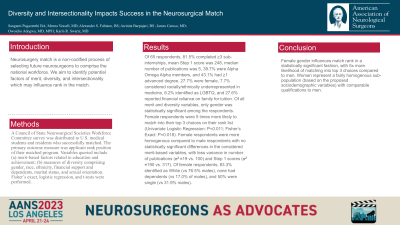Diversity and Intersectionality Impact Success in the Neurosurgical Match
Friday, April 21, 2023


Sangami Pugazenthi, BA
Medical Student
Washington University School of Medicine in St. Louis
St. Louis, Missouri, United States
ePoster Presenter(s)
Introduction: Neurosurgery match is a non-codified process of selecting future neurosurgeons to comprise the national workforce. We aim to identify potential factors of merit, diversity, and intersectionality which may influence rank in the match.
Methods: A Council of State Neurosurgical Societies Workforce Committee survey was distributed to U.S. medical students and residents who successfully matched. The primary outcome measure was applicant rank position of their matched program. Variables queried include (a) merit-based factors related to education and achievement; (b) measures of diversity comprising gender, race, ethnicity, financial support and dependents, marital status, and sexual orientation. Fisher’s exact, logistic regression, and t-tests were performed.
Results: Of 65 respondents, 81.5% completed >3 sub-internships, mean Step 1 score was 248, median number of publications was 5, 39.7% were Alpha Omega Alpha members, and 43.1% had >1 advanced degree. 27.7% were female, 7.7% considered racially/ethnically underrepresented in medicine, 6.2% identified as LGBTQ, and 27.6% reported financial reliance on family for tuition. Of all merit and diversity variables, only gender was statistically significant among the respondents. Female respondents were 5 times more likely to match into their top 3 choices on their rank list (Univariate Logistic Regression: P=0.011; Fisher’s Exact: P=0.018). Female respondents were more homogenous compared to male respondents with no statistically significant differences in the considered merit-based variables, with less variance in number of publications (2 =19 vs. 100) and Step 1 scores (2 =190 vs. 317). Of female respondents, 83.3% identified as White (vs 76.5% males), none had dependents (vs 17.0% of males), and 50% were single (vs 31.9% males).
Conclusion : Female gender influences match rank in a statistically significant fashion, with 5x more likelihood of matching into top 3 choices compared to men. Women represent a fairly homogenous sub-population (based on the proposed sociodemographic variables) with comparable qualifications to men.
Methods: A Council of State Neurosurgical Societies Workforce Committee survey was distributed to U.S. medical students and residents who successfully matched. The primary outcome measure was applicant rank position of their matched program. Variables queried include (a) merit-based factors related to education and achievement; (b) measures of diversity comprising gender, race, ethnicity, financial support and dependents, marital status, and sexual orientation. Fisher’s exact, logistic regression, and t-tests were performed.
Results: Of 65 respondents, 81.5% completed >3 sub-internships, mean Step 1 score was 248, median number of publications was 5, 39.7% were Alpha Omega Alpha members, and 43.1% had >1 advanced degree. 27.7% were female, 7.7% considered racially/ethnically underrepresented in medicine, 6.2% identified as LGBTQ, and 27.6% reported financial reliance on family for tuition. Of all merit and diversity variables, only gender was statistically significant among the respondents. Female respondents were 5 times more likely to match into their top 3 choices on their rank list (Univariate Logistic Regression: P=0.011; Fisher’s Exact: P=0.018). Female respondents were more homogenous compared to male respondents with no statistically significant differences in the considered merit-based variables, with less variance in number of publications (2 =19 vs. 100) and Step 1 scores (2 =190 vs. 317). Of female respondents, 83.3% identified as White (vs 76.5% males), none had dependents (vs 17.0% of males), and 50% were single (vs 31.9% males).
Conclusion : Female gender influences match rank in a statistically significant fashion, with 5x more likelihood of matching into top 3 choices compared to men. Women represent a fairly homogenous sub-population (based on the proposed sociodemographic variables) with comparable qualifications to men.
